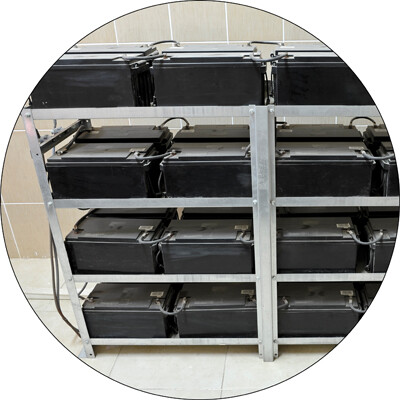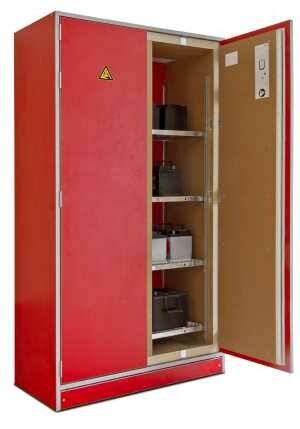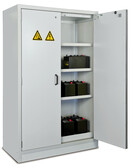We have been using lithium-ion batteries for a long time, mainly in the form known as 'stick-batteries', as well as batteries in all kinds of electronic equipment. However, we have been hearing about them much more frequently in recent years, thanks to vehicles with new ways of powering them: cars, scooters, bicycles and electric scooters, as well as drones. Find out more about these devices below.
What is a lithium-ion battery?
The most popular online encyclopaedia provides this definition: "an electric accumulator in which one of the electrodes is made of porous carbon and the other of metal oxides, and the role of the electrolyte is a liquid containing lithium salts dissolved in a mixture of organic solvents or a solid." (https://pl.wikipedia.org/wiki/Akumulator_litowo-jonowy).
According to another source, this is one of the most widely used types of electric battery today, and its name comes from its operating principle. When discharging the battery, lithium ions move from the anode (negative electrode) through the electrolyte to the cathode (positive electrode), while when charging it, the ions move in the opposite direction (https://e-magazyny.pl/baza-wiedzy/baterie-litowo-jonowe).
It should be made clear that a cell is not synonymous with a battery, but a component of it – li-ion batteries can contain up to several thousand cells.
Lithium-ion accumulator characteristics
It is worth familiarising yourself with the parameters relating to li-ion batteries so that you can more easily choose the right product for your application. Here are the more important ones:
• capacity: indicates the amount of charge that can be stored in the battery, expressed in ampere hours (Ah) and derived units,
- • life: indicates the number of charge and discharge cycles after which the capacity of the accumulator decreases below a certain value,
- • efficiency: the amount of energy that can be extracted from the battery in relation to the energy supplied by charging, given in %,
- • state of consumption (abbreviation SoH): percentage ratio of the maximum charge of the acumulator to the nominal capacity, decreases with the number of charge and discharge cycles,
- • state of charge (SoC): the current level of charge in relation to the total capacity of the battery, also given as a percentage,
- • depth of discharge (DoD): the percentage level of discharge of the battery, care should be taken not to exceed the value specified by the manufacturer, as this will reduce the life of the accumulator.
The main advantage of lithium-ion accumulators is that they weigh less than other types of these products. They can store considerably more energy than NiMH batteries of the same size and weight. They also do not suffer from the so-called memory effect, i.e. the actual or apparent reduction in capacity due to only partial discharge or overcharging. Another advantage is their low self-discharge, i.e. loss of charge when not in use.
Our Hartmann Tresore shop offers cabinets for lithium-ion batteries. You can choose a single or double-door cabinet, as well as a special portable cover for storing batteries in the storage space.
Areas of use for li-ion batteries
We already know about the use of lithium-ion accumulators as a cost-effective power source for laptops and notebooks, mobile phones and tablets. However, in addition to these, such batteries are used in portable medical devices such as pacemakers, hearing aids and defibrillators.
Another field of use is UPS devices, which provide hospital medical equipment, computers and servers with protected power in the event of a power failure.
Unstable petrol and diesel prices, environmental motives and the increasing number of charging stations are encouraging the development of the electric vehicle market. The lithium-ion batteries used here are more durable than those in other devices (up to 10 years) and are adapted to the operating conditions through cooling and heating systems. They can also be recharged quickly, which does not significantly affect the lifespan. Interestingly, even boats and yachts are emerging that use li-ion accumulators for power.
A lesser-known application for these batteries is as energy storage, which is essential for the operation of RES installations, i.e. renewable energy sources. Such storage facilities allow energy to be fed back into the grid when needed and excess energy to be stored.
How can you extend the life of your accumulators?
It is a good habit to take care of the life of the batteries in use by keeping a few tips in mind. Charge them as soon as possible after discharge and quite often. Unless you are not going to use them for a long time, discharge them to about 40% – such a level will give them a much longer life. On the other hand, li-ion accumulators should not be kept completely discharged, as they may become damaged.
It is advisable to limit or even not use functions that result in complete battery discharge. These can be found in laptops and mobile phones powered by nickel accumulators.
Lithium batteries should be stored in a cool environment, but should not be exposed to temperatures that are too low (below 0 °C) or too high, such as by leaving them near a heat source or in a hot car.
The temperature range best suited to accumulators is 10-25 °C. Do not risk charging them in an environment below 5 °C or above 30°C, as this may cause damage to the cells or even ignition, not to mention the loss of warranty.

The downsides of lithium-ion batteries
Earlier we learned about some of the advantages of the li-ion accumulator, but does it have any disadvantages? Here I will discuss two risks associated with the use of this type of power supply. Because of these, these products undergo a great deal of research, simulation and testing before they are commercially released. As users, we are unlikely to be immune to manufacturing defects, but we should store and operate the batteries properly and protect them from damage.
A lithium-ion battery can leak or spontaneously ignite if it is heated to a high enough temperature. This happens due to so-called thermal instability – a specific chain reaction that results in the evaporation of the electrolyte, then a pressure increase and the escape of flammable gases outside the battery. This phenomenon cannot be stopped and, as the battery cells lie next to each other, the heating of one battery cell causes the temperature of the others to rise. Burning batteries are very difficult to contain, and it is not uncommon to only be able to protect the surroundings from the spread of the fire.
The second issue is the risk of the battery exploding if the electrolyte structure is damaged or the battery is charged with excessive current. An explosion can also be caused by incorrect charging causing the permitted voltage to be exceeded and subsequently reducing the usable capacity of the battery. Storing li-ion batteries for long periods of time without use has a similar effect – they can be inadvertently overcharged when reused.
Then there is the environmental aspect regarding the production of lithium-ion batteries. The rare metals needed for it are mainly extracted in the poor countries of South America and the Democratic Republic of Congo. The extraction of lithium results in increased water consumption in one of the driest areas of the world, the Andes. The population, mostly agricultural, is thus forced to relocate. In the Congo, on the other hand, water is being contaminated with sulphur compounds and dust is being created with toxic metals, which is becoming dangerous for residents and animals.
So let's use lithium batteries sensibly and ecologically, remembering that they cannot be disposed of in municipal waste or segregated waste. They need to be handed over to certified cell recyclers, especially as the vast majority of valuable raw materials can be recovered from them: cobalt, lithium and graphite.
Find out more about li-ion accumulators: How to store lithium-ion batteries safely?
Social Security subsidy for the purchase of cabinets for hazardous and flammable materials





